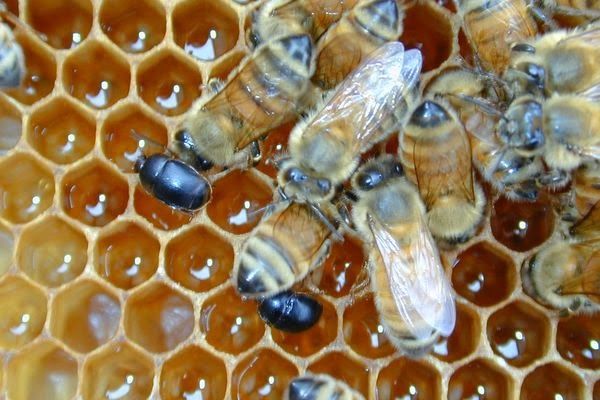About Small Hive Beetle (SHB)
Although the small hive beetle (Aethina tumida) is only 5 mm long, it is one of the most feared bee parasites because with a heavy infestation, it can destroy an entire colony within a very short time. Compared to the African subspecies, which have developed control mechanisms as the original host of the hive beetle, the European subspecies are unlikely to achieve this. New Zealand is one of the countries lucky not to have this pest.
The small hive beetle (Aethina tumida) came originally from Africa, south of the Sahara. Since 1998, it has been unintentionally introduced to the United States, Canada, Mexico, Jamaica, Australia and Cuba, and has spread and caused tremendous damage there. In 2004, the beetle was first discovered in Europe, in Portugal, during delivery of queen bees and it was successfully destroyed. Unfortunately, the small hive beetle reached Italy in 2014 and has rapidly spread there ever since.
In its original homeland of Africa, the small hive beetle is considered a rather harmless pest. African honey bees have developed defence mechanisms. Compared to their European cousins, they find infested brood cells faster and clean their stock more thoroughly, before they swarm. This takes away the bug’s basis for nutrition and multiplication.
In addition, the African honey bees confine the small hive beetle in a stable prison that they built from the collected bee glue, the so-called propolis. Even the guard bee is placed there to monitor the enemy. This is how the honey bees fight the voracious beetle, however, the beetle has also learned from that: The beetle imitates the behaviour of begging bees to obtain food, which allows it to survive in its prison for up to two months. Luckily, it cannot mate and multiply under these conditions.
What does the small hive beetle look like?
The SHB is a brown-black, compact beetle measuring 0.5cm long. It sports two clubbed antennae, six legs, and a distinct separation between the thorax and abdomen.
How does the small hive beetle infect the hive?
The SHB is capable of flying up to 20 kilometres, meaning it can travel to a new hive rather fast. This makes it especially dangerous and a quick multiplier.
The way SHB infecs a hive is rather cunning. The beetles have evolved to avoid the bees’ attack instinct by imitating the behaviour of bees begging for food.
An adult SHB can survive for two weeks without food and water, 50 days eating used comb and many months on fruit. If the honeybees are kind enough to let it stay, it can survive up to two months in the hive unnoticed by the colony.
After successfully entering the hive, the SHB lays its eggs in a safe place, usually an area that cannot be accessed by the bees. These eggs hatch larvae after two to six days. The larvae feed on honey, beeswax and pollen, which very quickly destroys the structure of the comb. Altering the delicate comb structure results in honey spoilage, leaving the colony and beekeeper without honey. Some bee colonies even leave the infested hive in an emergency swarm.
The pupation of the beetle takes about 3-4 weeks and takes place in the soil below or near the hive. Since the pupation is highly dependent on the temperature and humidity of the soil, the duration can vary significantly.
Signs of SHB in your colony:
- Small brown-black beetles running around the comb or hiding in cool, out-of-sight areas of the hive
- SHB larvae burrowing through the brood combs
- SHB larvae eating brood and their food stores
- SHB larvae grouping in clumps either in corners of frames or comb cells
- Any suspicious clumps of small eggs in the cracks of your hive. These may look like small grains of rice
- Honey fermenting or dripping out of the cells
- Slimy-feeling comb
- A smell of rotten oranges coming from the combs
How to treat and prevent small hive beetle?
A strong hive can keep on top of small hive beetle. Ensure that your bees don't have too much space in the hive that they may be unable to protect - such as empty supers that they're not strong enough to fill yet. After a season of drought, increased rainfall, or fires, building a strong hive may require feeding your bees, using pollen supplements, or using brood booster. Check out our many YouTube videos on feeding and building strong hives through tough times. Check out our feeding and nutrition range for help!
Unnecessary gaps that your bees can't fit into and patrol can create a SHB highway in your hive. These small gaps and crevices might be in the edges of your box, in your lid, or even the edges of standard plastic frames. Check your hiveware to ensure that there aren't any unnecessary caps and crevices that SHB could hide in. Upgrade your plastic frames to our Beetek Plus+ frames with an edge-to-edge design that provides 7-13% more space for honey/brood (helping you to build a strong hive!) and nowhere for SHB to hide!
Add one of our guardian beehive entrances. The design forces beetles to stay along the edges with the help from bee pressure - aiding your bees in protecting their colony and reducing the number of beetles that would normally be allowed to march into your hive.
Use one of our most popular Hive Doctor Smart Bottom Boards and add our pest checking trays! The bees will drive the SHB through the mesh bottom board, and into the tray which you can fill with a liquid like canola oil to kill the SHB. Checking your pest trays will help you to monitor the levels of SHB in your hive, without opening it - extra handy for cold or windy days where an inspection isn't possible! We've linked our bottom boards and pest trays below!

